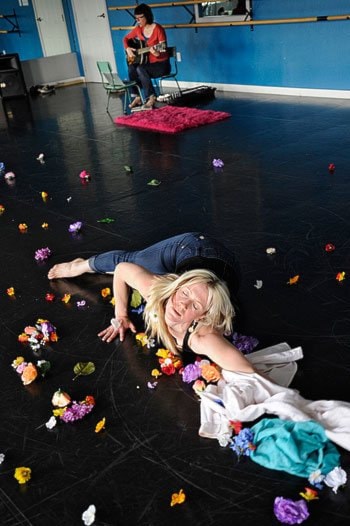In 1980, Quebecois dance artist Marie Chouinard walked on stage with a bucket, put it down, urinated in it and then walked off stage.
It was called La petite danse sans nom, and it catapulted her career.
She’s simulated masturbation on stage. She’s also choreographed multiple pieces where the dancers wear little but tassels, and others where props, stilts and costumes turn dancers into whimsical monsters.
Chouinard’s work didn’t just establish her own name, but helped to truly begin blurring lines, genres and expectations in performance art across Canada.
Yet despite three decades, dancers who continue to push the envelope still find themselves worried about audience expectations.
“Some people like to see their dance be a certain thing,” said local choreographer Monique Romeiko. “Once in awhile, I worry that people see this word ‘dance’ and then assume that it’s going to be beautiful and walk in with an expectation that it’s going to be beautiful. But it isn’t always beautiful.”
Romeiko’s newest piece, Re: is on the bill for this week’s Homegrown Theatre Festival.
And while Bronwen Kettleson, the dancer in Re:, may not pee on stage, Romeiko is doing her part to continue blurring those lines.
In fact, she cringes slightly when people try to define what genre Re: fits into.
Even when Romeiko describes it, she says the word “slash” between nouns and adjectives as often as other people say “ummm.”
It’s a blur of both theatre and dance.
But calling it contemporary dance wouldn’t necessarily be right, said Romeiko, because nowadays that term has become broad enough to include everything from Chouinard to break dancers.
“In my day, I’m a bit older,” the new mom said smiling. “But in my day, it was modern dance so we were very, very highly trained in certain styles, like ballet and modern (think Martha Graham). But now contemporary dance has slid into a new arena, which is including a lot of urban dance styles, break dancing and jazz in particular. And due to the influence of So You Think You can Dance, it’s also changing because people are using the broad term of ‘contemporary.’”
But Re: isn’t strictly theatre either.
“I still use my training and my background but I’m less focused on dance-movement execution than content,” said Romeiko.
And theatre has begun to blur over the years also, she added.
The incorporation of multimedia, like film, and other art forms like spoken word have begun to muddy the waters of traditional theatre. Not to mention, the stage itself is changing. Traditional venues are becoming outdated by more conceptual and aggressive performances like public exhibitions in shared spaces like parks or street corners.
“And I think sometimes in theatre, people want a (straight) storyline and I’m not delivering that,” Romeiko added. “I think I’m making art.”
The piece also offers a score performed live by local singer/songwriter Kim Barlow.
But essentially, Re: follows the story of one main dancer, Kettleson.
“It’s a broken-up love comedy/tragedy,” Romeiko said. “And while the story’s focused on the dancer ... there’s other wildcard elements. It’s almost like two stories in one - kind of like an apartment: different people living their lives, side-by-side.”
And the piece reads more like a series of vignettes rather than a chronological plot.
“I had made a catalogue of movements,” she said. “That had been taken apart and rearranged as one option that we’re going to show.”
But at the end of the day, like most art, the piece is really about the most sincere and natural parts of us, as humans.
“It’s about love, life, sex, death, babies, music,” said Romeiko. “I’d originally said it was underwater heartbreak and earthly desires. I actually choreographed some of the movements in the ocean after experiencing a breakup a few years ago.
“And then Kim Barlow’s song, Hide in the Sea, exactly captured what I was doing, I was literally hiding in the sea and just moving my body around. So I thought it would be nice to make a piece with an underwater feeling to it.
“So whether that comes out or not, I’m not sure.”
Gender roles figured prominently in a chaotic rehearsal, performed to Barlow’s live strumming and singing. High heels, flowers and an oversized men’s button-up dress shirt are strewn about by Kettleson’s floor work of rolls and arches.
Her movements graduate to full-arm swings, like Pete Townshend’s windmill guitar strums before Kettleson evolves to a marathon of full body attitude turns.
“I can’t promise to fulfill anyone’s expectations of anything,” said Romeiko, noting that in the realm of performing arts, Whitehorse is still nowhere near the likes of major cities that showcase different types of theatre, dance and performance art on any given night at any given theatre. “We just don’t have the exposure up here. Not yet. But having this fringe festival idea is a great one for experimentation.”
Re: will be preformed on Thursday, May 10 at 7:35 p.m. and Sunday, May 13 at 2:35 p.m. at the Guild Hall Theatre. Tickets are $10.
For more information about the North’s only fringe-style festival and the other plays and pieces that will be preformed, visit www.nakaitheatre.com
Contact Roxanne Stasyszyn at
roxannes@yukon-news.com
